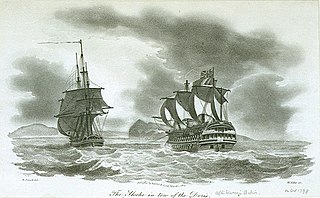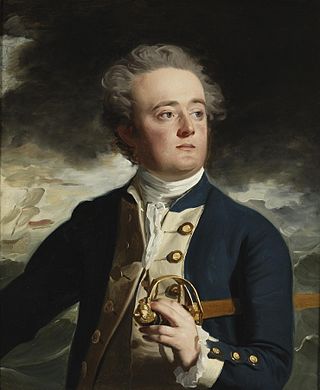Twelve vessels of the French Navy have been named Duguay-Trouin in honour of René Duguay-Trouin.

HMS Doris was a 36-gun fifth-rate frigate of the Royal Navy, launched on 31 August 1795. which saw service in the French Revolutionary and Napoleonic Wars. Doris was built by Cleveley, of Gravesend.
HMS Albemarle was a 28-gun sixth rate frigate of the Royal Navy. She had been built as the French merchantman Ménagère, which the French Navy purchased in 1779. A British squadron captured her in September and she was commissioned into service with the Royal Navy. Amongst her commanders in her short career was Captain Horatio Nelson, who would later win several famous victories over the French. The Navy sold her in 1784. She subsequently became a merchant vessel again. In 1791 she transported convicts to Port Jackson as part of the third fleet. She then sailed to India where she picked up a cargo on behalf of the British East India Company. As she was returning to England a French privateer captured her.

HMS Ferret was a Royal Navy Cruizer-class brig-sloop built by Benjamin Tanner at Dartmouth and launched in 1806, 19 months late. She served on the Jamaica, Halifax, and Leith stations during which time she took three privateers as prizes before she was wrecked in 1813.

The Sunda Strait campaign of January 1794 was a series of manoeuvres and naval actions fought between warships and privateers of the French Republic and a squadron of vessels sent by the British East India Company to protect trade in the region, later augmented by Dutch warships. The campaign developed as French forces based on Île de France reacted more quickly than the British forces in the Indian Ocean to the expansion of the French Revolutionary Wars on 1 February 1793. French privateers rapidly spread along the British trade routes in the Far East, becoming concentrated around the narrow Sunda Strait between the islands of Java and Sumatra in the Dutch East Indies. These ships were soon joined by French Navy frigates and began to inflict losses on shipping in the region. The Royal Navy forces in the Indian Ocean were deployed elsewhere and so the East India Company, the private enterprise that ruled much of British India in the 1790s and maintained their own fleet and navy, raised a squadron of armed merchant ships to patrol the Strait and drive off the raiders.
The action of 5 May 1794 was a minor naval engagement fought in the Indian Ocean during the French Revolutionary Wars. A British squadron had been blockading the French island of Isle de France since early in the year, and early on 5 May discovered two ships approaching their position. As the strange vessels came closer, they were recognised as the French frigate Duguay Trouin, which had been captured from the East India Company the year before, and a small brig. Making use of a favourable wind, the British squadron gave chase to the new arrivals, which fled. The chase was short, as Duguay Trouin was a poor sailor with many of the crew sick and unable to report for duty. The British frigate HMS Orpheus was the first to arrive, and soon completely disabled the French frigate, successfully raking the wallowing ship. After an hour and twenty minutes the French captain surrendered, Captain Henry Newcome of Orpheus taking over the captured ship and bringing his prize back to port in India.

John Loring was an officer in the Royal Navy who served during the American War of Independence and the French Revolutionary and Napoleonic Wars.

The Battle of Île Ronde was a minor naval engagement between small French Navy and British Royal Navy squadrons off Île de France, now named Mauritius, in the early stages of the French Revolutionary Wars. The battle was fought over control of the waters around Île de France, which was under blockade from the British squadron as French warships and privateers operating from the island posed a significant threat to vital British trade routes connected to British India and China.
Phoenix was an East Indiaman, launched in 1785. She made six voyages for the Honourable East India Company (HEIC). On her sixth voyage, while under the command of Captain William Moffat, she captured the French 14-gun privateer Malartic. In 1803 her owners sent her out to India to sail in the coastal trade; her subsequent fate is unknown.

Four vessels with the name Princess Royal have served the British East India Company (EIC).
Pigot was an East Indiaman that made five voyages to India, China, and the East Indies for the British East India Company (EIC) between 1780 and 1794. Oh her fifth voyage, which occurred early in the French Revolutionary Wars, the French captured her during the Sunda Strait campaign of 1794.

The East Indies theatre of the French Revolutionary Wars was a series of campaigns related to the major European conflict known as the French Revolutionary Wars, fought between 1793 and 1801 between the new French Republic and its allies and a shifting alliance of rival powers. Although the Indian Ocean was separated by vast distance from the principal theatre of the conflict in Western Europe, it played a significant role due to the economic importance of the region to Great Britain, France's most constant opponent, of its colonies in India and the Far Eastern trade.

During the late 18th and early 19th centuries, many French privateers and letters of marque bore the name Duguay-Trouin, named for René Duguay-Trouin: René Trouin, Sieur du Gué, French privateer, admiral and Commander in the Order of Saint Louis. Between 1760 and 1810, warships of the Royal Navy captured seven different French privateers all with the name Duguay-Trouin.
HMS Duguay-Trouin was an 18-gun French privateer sloop launched in 1779 at Le Havre. Surprise captured her in 1780 and the British Royal Navy took her into service under her existing name. It sold Duguay-Trouin on 30 October 1783. She then became the West Indiaman Christopher. She captured several French merchant vessels. Later she became a Liverpool-based slave ship, making five voyages in the triangular trade in enslaved people. She was lost at Charleston in September 1804 in a hurricane.

Houghton was launched in 1782 and made six voyages as an East Indiaman for the British East India Company (EIC). In 1794 she was part of an EIC squadron that had some success against French privateers and naval vessels in the Sunda Strait, and then in 1796 she participated as a transport in the British capture of St Lucia. She was sold in 1799 and her owner took her out to India to work in the tea trade between India and China. She foundered in 1803.

Nonsuch was launched at Calcutta in 1781 as the first large vessel built there. She was designed to serve as either a merchantman or a man-of-war. She spent the first 12 years of her career as a merchant vessel, carrying opium to China amongst other cargoes. After the outbreak of the French Revolutionary Wars in 1793 her owner frequently hired her out as an armed ship to the British East India Company (EIC). She participated in an engagement with a French naval squadron and recaptured an East Indiaman. She also made two voyages for the EIC. After the Peace of Amiens in 1802 the EIC paid her off; as she was being hauled into a dockyard for repairs she was damaged and the decision was taken to break her up.
Princess of Wales was launched at Stockton in 1795. She made three voyages as an "Extra ship", i.e., under charter, for the British East India Company (EIC). On her return she became a West Indiaman. A privateer captured her in 1803 as she was coming back to England from Jamaica, but British privateers immediately recaptured her. She continued sailing to Jamaica though later, under a new owner, she traded more widely. She probably foundered in 1828, and is last listed in 1830.
Britannia was launched by the Bombay Dockyard in 1772, and was rebuilt in 1778. The British East India Company (EIC) apparently acquired her in 1775. Between 1779 she made eleven complete voyages as an East Indiaman for the EIC. She also participated in three naval campaigns, during the first of which she was deployed as a cruiser off Sumatra. There she engaged and captured a French ship. In the other two she served as a transport. She set out for her twelfth EIC voyage but was lost in 1805 during the third naval campaign.
Baron de Binder was launched in 1782. She made two voyages as a slave ship in the triangular trade in enslaved people. Then in 1793, she became the privateer Duguay-Trouin. After one cruise, the French Navy requisitioned her, and she served as a corvette for almost three years. The navy returned her to her owners, who sailed her as a privateer again. In 1798. the British Royal Navy captured her.
William Pitt was launched on the River Thames in 1785 as an East Indiaman. She made six voyages for the British East India Company (EIC). During her fourth she served as an ad hoc warship in a naval campaign during which she saw action. Thereafter she served as a transport, including one voyage in 1801-1802 transporting rice from Bengal to Britain. She was sold for breaking up in 1809.









